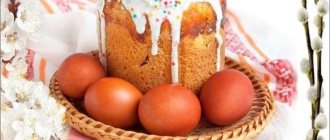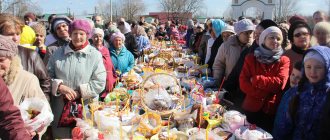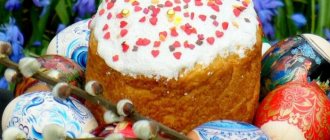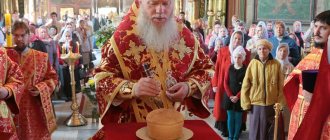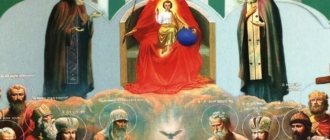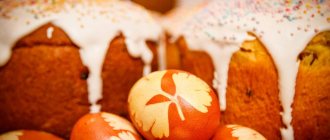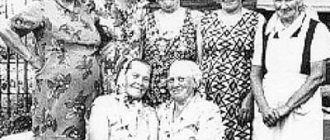What date is Easter for Orthodox Christians in 2022?
It must be a surprising phenomenon from the outside: where Orthodox Christians who regularly participate in church life and receive the Sacraments make up no more than 10% of the population, this holiday is celebrated by almost the majority. Not always deeply familiar with religious traditions, our compatriots, however, most often know: Easter in 2022 falls on April 24. But every year the date of celebration according to the church calendar falls on a different date.
When do Orthodox and Catholics celebrate Easter in 2022?
It will be a Sunday: no matter what date the celebration falls on, the day of the week, anciently named for the event of the Resurrection of the Lord, remains unchanged.
- April 24 - Orthodox Christians celebrate;
- April 17 – Catholics
Orthodox Easter in 2022 in Belarus is the same as in Russia - April 24.
It is preceded by Lent. The beginning of the Great Year in 2022 falls on March 7 .
Signs and beliefs
- If all the snow melts by Easter, there will be a good harvest this year.
- If you feed street birds with bread crumbs on holiday, you will be blessed with good luck and wealth all year long.
- If you manage to see the Easter sunrise, you should expect good luck in business.
- A housewife who bakes successful Easter bread will have prosperity and well-being in her home.
- After the service in the temple, it is necessary to extinguish the candle for good luck. A candle that goes out during a service is a bad omen.
Easter is a great Orthodox holiday. On this day, Christians attend services where Easter cakes and colored eggs are illuminated. People are trying to free themselves from household chores and spend time with their loved ones.
Why does Easter always fall at a different time?
There are different opinions about when historically the event occurred that opened up a new life for humanity - with God. For example, many Christians since ancient times believed that this happened on April 7th. This is also the day of the Annunciation of the Virgin Mary .
Interesting fact
When Easter falls on April 7, such a day is called in a special way - Kyriopascha, that is, “Lordly”. This happens infrequently: the last such coincidence happened in 1991. And the next Kyriopascha will be celebrated only in 2075.
However, Christians of the first centuries were not inclined to calculate the “times and dates” of events. Much more important was their spiritual meaning. That is why the celebration of Easter was never correlated with the historical day of the Resurrection: for example, the first Christians of God celebrated the “Rising of Christ” in general every first day of the week - this is where its name, Sunday. In addition, there was also the memory of the Crucifixion, a day of strict fasting and mourning.
This Easter was called “Godfather”, it was the eve of the Passover holiday among the Jews. After all, it was then that Jesus was crucified. But already from the end of the 2nd century. Easter becomes the holiday of the “mortification of death”, the Resurrection of the Lord.
Maslenitsa 2022, what date and when is Easter, Radonitsa. Moving dates of the Orthodox calendar.
This order first appeared in 325. Then the First Ecumenical Council established the principle of annually determining the date of the “Feast of Feasts”:
- the starting point is March 21; that is, the spring equinox; since ancient times it was the end of winter, the beginning of spring;
- the first full moon is counted from it;
- The Sunday following the full moon is Easter.
At the same time, it is well known: Christ rose again after the Passover of the Jews. Therefore, Christian Easter should logically not be earlier than Jewish Easter. If such a coincidence occurs, the Christian celebration is postponed after the full moon of the next month.
Why is the main holiday of Christians “movable”? The lunar month (from new moon to full moon) is 28 days, which diverges from the solar calendar - the date of the equinox is determined by it. Taking into account the fact that the Christian Easter should neither coincide with the Jewish one nor precede it, the dates of the holidays change from year to year. This could be from April 4 to May 8 (counting according to modern civil, “new style”).
About the Holiday
The Jewish Passover, according to the holy fathers of the Church, was a prototype of the Christian one:
- the sacrificial blood of a lamb, which the Jews applied to the doorposts on the night of their exodus from the Egyptian land, saved them from death - and the Blood of Christ, His Sacrifice on the Cross, saved people from sin;
- the Jews left the country where they were slaves to Palestine - the Promised Land, that is, promised to them by God Himself, and Christians, through the Resurrection of Christ, are led out of the kingdom of sin, the evil of this world to a new life with the Lord; , lost after the fall of Adam and Eve, .
Events
After the Crucifixion of the “Preacher from Galilee,” it seemed to the Jewish elders and priests that the preaching of the One whom many considered the Messiah, the Savior, was over, and the confusion among the Jewish people also ceased. His followers, disciples, according to their own later testimony, “left Him and fled” (Matthew 26:56). “Fear for the sake of the Jews,” that is, fearing also to be arrested and handed over for execution, they, who until recently had been so eager to fight, even to die for the Teacher, hid and lay low.
All the more shocking is what happened “after the Sabbath,” the day of rest. Then several women (the first of them the Evangelists usually call Mary Magdalene, one of the most zealous followers of the Teacher) went to the tomb of Jesus to complete the funeral rites. After all, for the sake of the coming Sabbath of peace and inactivity, the Crucified One was buried very hastily.
But the tomb cave suddenly turned out to be empty. Moreover, the entrance to it, blocked by a huge stone, was open. The body of Christ was not there - and after a short time, first the myrrh-bearing wife, then close disciples met Him alive. This is how the Easter exclamation sounded for the first time - something that was passed from mouth to mouth first by the Apostles, then by the inhabitants of Jerusalem: “Christ is Risen!”
Traditions
If Jews celebrate Passover for 8 days, then Christians greet each other with Easter greetings for as many as 40, until the Feast of the Ascension of the Lord. The most solemn days are considered to be the days after the Resurrection - Bright Week. This is a time when there are no fast days; joyful services are held in churches, where there is more singing than reading. And even the commemoration of the dead is not performed for the sake of the Resurrection.
Easter evening service in the Archangel Michael Cathedral in the city of Izhevsk. Photo from the archive of the press service of the Udmurt diocese, 2022.
Perhaps the most famous Easter tradition is Easter eggs, traditionally painted red (later other colors appeared, as well as decoration with patterns, such eggs began to be called “pysanka”). It is believed that Mary Magdalene was the first to give a painted egg (according to another legend, it miraculously changed color to red). Coming to Emperor Tiberius with this unusual, symbolic gift, she greeted him, saying: “Christ is Risen!”
Until Easter
These customs began to take shape from the first centuries of the Church, when believers moved from the “Easter of the Cross” to the joyful celebration of the Resurrection of Christ.
Maslenitsa
Maslenitsa in Russia was traditionally called the last week before the start of Lent. The Church no longer blesses believers to eat meat, but entering into the long period of fasting is gradual, and during the “Shrove Week” you can eat fish, dairy, and eggs. At the same time, liturgy is not supposed to be celebrated on Wednesday and Friday of the week. During the morning services of these days, for the first time, a prayer of repentance written by St. Ephraim the Syrian - a short but powerful prayer, which will then be repeated more than once during services.
Fasting before Easter
Back in the 1st-2nd centuries, when “Easter” was understood to be the remembrance of the Crucifixion of Christ, such fasting was short - from 1 to 3 days - and represented complete abstinence from food. Subsequently, gradually the tradition of forty days of preparation for the “Feast of Holidays” began. It is called “Holy Lent” or Great Lent. Moreover, the total number of days of fasting before Easter is greater, since Lent is followed by Passion Days, when believers experience Christ’s path to the Crucifixion.
Interesting fact
Now in the Russian Church, where the Jerusalem liturgical Charter has been in force (since the 14th century), Christians do not eat fish or any food of animal origin. However, until the 17th century. there were monastic monasteries that lived according to a different Charter, dating back to the Constantinople monastery of St. Theodora Studite. This holy father blessed less strict abstinence, for example, eating fish more often, whereas according to the Jerusalem Rule it is only prescribed for the holidays of the Annunciation and Palm Sunday.
Each of the Sundays of the Four Days is dedicated to events in church history that are honored by the saints of God.
In 2022, Lent will begin on March 7 and will last (including also Lazarus Saturday, Palm Sunday and Holy Week) until April 23 inclusive.
Many Christians try to attend services whenever possible, especially in the evenings during the first four days. Then a special Canon sounds, written by St. Andrey Kritsky. It can also be heard during the fifth week: on Wednesday evening, believers come to a special, touching service dedicated to St. Mary of Egypt, called the “Standing of Mary”.
Traditions and rituals of the holiday
Easter is the main holiday of Christianity. On this day, a solemn service is held in churches. It starts before midnight. First, the Midnight Office is served, during which the priests take the Shroud to the altar and place it on the throne. Matins begins at midnight. The clergy sings a festive stichera in the altar. Then the clergyman makes a religious procession - a walk around the temple while the bells ring. In his hands he holds a lantern with a burning candle inside. He is followed by representatives of the clergy with church relics. The religious procession is accompanied by the singing of stichera. After going around the temple, Matins continues. Integral parts of the Easter service are the Easter Hours and the Liturgy of St. John Chrysostom.
In many churches, parishioners are allowed to ring bells on this day. Anyone, accompanied by the clergy, can climb the bell tower and try themselves as a bell ringer.
On Easter Sunday, churches consecrate Easter cakes, Easter cottage cheese, colored eggs (krashenki, pysanky) and other treats prepared for the festive table. People put food in a wicker basket, cover it with a beautiful towel and go to temples to bless it. Also on Easter, artos - leavened bread - is blessed in churches. It is distributed to believers to keep at home for a year. Artos is taken on an empty stomach for illnesses.
Have an interesting day
Today's task: Bake your own homemade cake
Kulich is a bread symbol of Easter, an indispensable attribute of the bright Christian holiday. Baking Easter cake and consecrating it in church is one of the most ancient Christian customs that has survived to this day. Each housewife has her own tricks for baking delicious Easter cakes, which are traditionally passed down from generation to generation, from mother to daughter.
For a long time, Easter cake was considered successful if it turned out to be tall, airy and soft. Today, there are many recipes for holiday Easter cake: with and without baking, with and without flour, traditionally decorated with icing and decorated with all kinds of elements. Only one thing remains unchanged - you need to prepare paskas with bright thoughts, putting all your love into them.
Bake your own homemade and specially flavored Easter cake and share the recipe.
One of the attributes of the holiday is flowers. People light up live or artificial bouquets at services. Then they bring them home, place them in front of the icons, and decorate the festive table with them.
On Easter, people greet each other with the phrase: “Christ is risen!”, to which they are supposed to respond: “Truly he is risen!”
Families have a tradition of measuring strength by breaking Easter eggs. The family member who breaks all the eggs and remains intact is considered the strongest.
On this day it is customary to visit relatives, spend time with family, organize festivities and entertainment. In some regions, this holiday is called “Green Christmastide,” during which people sing ritual songs, congratulate loved ones, go from house to house, praise the owner and wish well-being.
Many people believe that the heavens open on Easter. Therefore, they perform magical rituals on this day. Young girls cast love spells on their beloved men and tell fortunes about their betrothed. Traditional healers believe that the Easter holiday period is the best moment for healing from illnesses.
Parents' Saturdays
On the eve of the beginning of Lent, you can submit notes “for Great Lent,” both about the health and the repose of relatives and loved ones. They are read by clergy during weekday services. However, the peculiarity of Lent is that during it the full liturgy, with the removal of particles from the prosphora for the repose of deceased Christians, is performed only on Saturdays and Sundays.
Thus, the dead seem to be somewhat deprived of church prayer. Caring for her children who are in another world, the Church from ancient times established three Saturdays during Lent, called by the people Parents' Days. This is the second, third, fourth Saturday of Lent.
What is the essence of Lent and why is it needed?
In the Church, the main purpose of Lent is considered to be a demonstration of the strength of the spirit over the strength of the body. This period consists of two unequal parts: Holy Pentecost and Holy Week.
The first lasts forty days: the Israelites wandered through the desert for exactly the same amount of time, and the prophet Moses and Jesus Christ fasted for the same amount of time.
Holy Week is the final, seventh week of Lent. It is dedicated to the suffering of Jesus in the last days of his stay on Earth.
During Lent, believers voluntarily give up certain foods and limit themselves to entertainment and pleasure. It is believed that Christians should spend this period in deep repentance, self-knowledge, spiritual cleansing and the fight against their vices.
